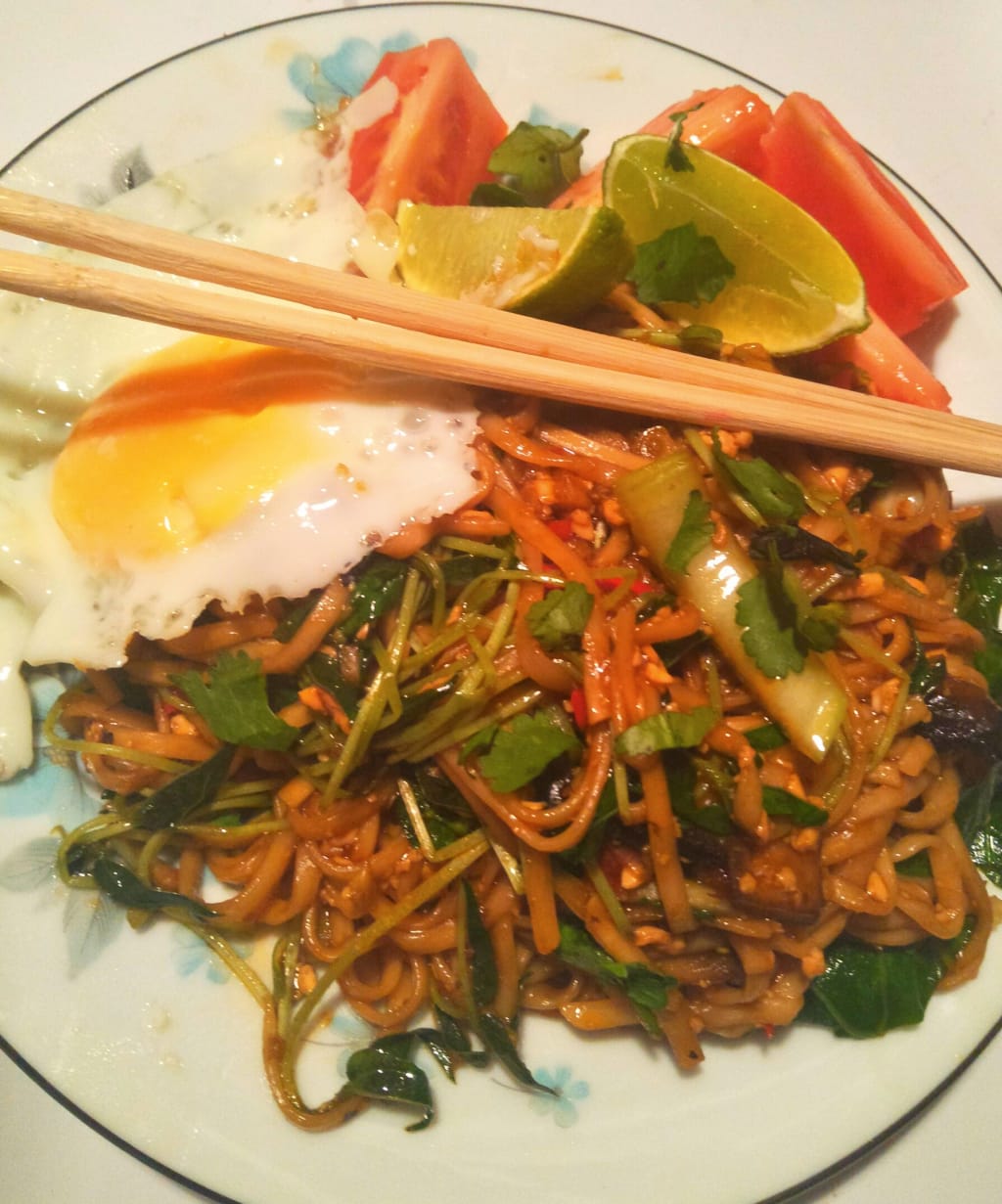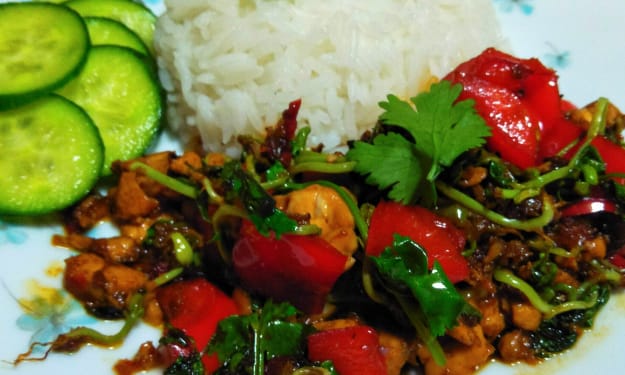Ungu Mee Goreng
A thoughtful approach to fried noodles

I can see how you might be curious about the title of this recipe. Perhaps you’re trying to work out where the “Ungu” region is. Or perhaps you understood the title but are wondering why I would make “purple fried noodles”. The dish is not named for its colour (although I’ve added some purple onion), rather it is named for the friend who inspired me to create it.
Violet is concerned with the environment, animal welfare and sustainable living. Recently, she voiced her dismay at discovering that most of the noodles she likes to eat are made with palm oil; a product responsible for large scale land clearing and habitat loss in South-East Asia.
Violet describes herself as ‘flexitarian’; she prefers to eat vegetarian however, does not strictly adhere to it. In designing this recipe, my goals were – to contain no palm oil, minimal meat products (it is not a strictly vegetarian recipe; however, it could be easily adapted) and minimal plastic packaging.
Palm oil and noodles
Oil palms are a highly productive crop producing much larger volumes of oil than other common crops. It is a lucrative industry, but large-scale production comes at a cost. As oil palms only thrive in tropical climates, large areas of rainforest are cleared, especially in Indonesia and Malaysia, to make way for plantations. These rainforests are precious, not only for their contribution to the climate of the world, but also as the home to orangutans and many other endangered species. I’m sure you’ve seen the iconic image of a lone orangutan trying to fight off a bulldozer. Now, don’t try to tell me that didn’t make you cry just a little.
Many varieties of noodles contain palm oil. Some will list vegetable oil as an ingredient however, this could conceivably be any plant-based oil and without probing deeper, one cannot know which type is used. For the purpose of this recipe, I have assumed that the manufacturer has opted for the cheapest oil available; palm oil. To be safe, I have avoided all noodles that list oil as an ingredient.
Hokkien noodles are an ideal choice for mee goreng, but you need to be selective with the brand you choose. I have found that Kan-Tong brand wok ready noodles do not contain oil, while the same varieties in the Wokka brand do. Check your ingredients when purchasing.
Vermicelli, whether rice or bean thread, and rice stick (pad) noodles aren’t made with oil either. However, they would not be the best choice for this recipe. To be a little different, I have gone with dry egg noodles, again a variety that is not made with oil. I will discuss the other ingredients after I tell you what they are. Here’s what you will need:
For the noodles
• A good splash of peanut oil
• 200g dry egg noodles (or your choice of noodles)
• 150g firm tofu, cut into small cubes
• 3 cloves of garlic roughly chopped
• 1 piece of ginger (half the size of your thumb) peeled and grated
• 1 large field mushroom, peeled and roughly chopped
• 1 small purple onion, quartered and sliced
• 2 shallots roughly chopped
• 1 bok choy, roughly chopped
• A good handful of bean sprouts
• A small handful of coriander, shredded (save about a third for serving)
• 1 large cayenne pepper, cut length ways and then sliced
• A dash of sesame oil
For the sauce
• 2 TBS kecap manis
• 2 TBS oyster sauce (vegetarian alternatives are available)
• 2 TBS light soy
• 1 TBS sambal
• 1 tsp dark soy
For serving
• Tomato wedges
• Lime wedges
• Fried shallot
• Reserved coriander
• Fried egg
Ingredient selection
I always recommend buying your fresh ingredients from small, local businesses instead of the big supermarkets. There are several reasons for this. The quality of the produce is one; supermarkets fill their shelves with produce grown to look good and keep longer, at the expense of taste and nutrition. You only need to compare the garlic from a small greengrocer to that which is available in the supermarket to know this is true. The supermarket isn’t that much cheaper either and you know you’re supporting a local and not a mega corporation.
The other reason is plastic. It horrifies me how much fresh produce is needlessly packed in plastic at the supermarket. Sure, you will still find some at the greengrocer, but it is less likely to be pointless packaging. If you do find a product with pointless packaging at the grocer, they’re more likely to listen to you if you request that they stock a line without the plastic.
It is inevitable that you will come across some plastic. Noodles are always packaged in plastic (unless you make your own). Bean sprouts too, come packaged in plastic, although growing your own is a lot easier than making your own noodles. I’ve found that while herbs are always in plastic from the supermarket, they are only sometimes packaged from the grocer (and at my local grocer, bunches of herbs are about a third of the price of the supermarket). If you’re able to grow at least some of your own herbs, not only will you reduce plastic waste, but also product waste as you’re only picking what you need.
For this recipe, I was able to source organic garlic (big taste difference here) and lime at a reasonable price. The eggs were pasture raised. If the cost of pasture raised eggs are prohibitive, then choose free range or at least, barn raised (cage free). Please avoid caged eggs. I have worked in a battery farm before and I promise you, the conditions the hens are kept in is atrocious.
If you are thoughtful in the selection of your ingredients, not only can you reduce your impact on the planet, you will also find that the resulting depth of flavour in your dish is far superior to what you could have made with cheaper, mass produced, plastic wrapped ingredients.
Method
Preparation is the key to all Asian cooking. Plan ahead and make sure you have everything ready before starting to cook.
1. Prepare the noodles according to the packet instructions. Once cooked, drain them, rinse them in cold water and toss through the sesame oil. Egg noodles are usually quite long and you may like to cut them into shorter strands once cooked.
2. Combine the tofu, onion, garlic and ginger in one bowl. In another place the mushroom, bok choy, shallots and chilli.
3. Combine the sauce ingredients in a third bowl or a cup. Have your bean sprouts and coriander ready. Prepare your toppings. Now you’re ready to cook.
4. Heat the peanut oil in the wok to a high temperature. Add the first bowl (tofu, onion et cetera) and stir for several minutes, until the ginger and garlic are highly fragrant and the tofu is starting to change colour.
5. Add the second bowl (bok choy, shallots and chilli) and stir for just a minute until the bok choy starts to wilt. Stir though the sauce mixture and continue cooking until the sauce is heated through.
6. Toss the noodles through the wok and combine with the vegetables and sauce. This is easiest to do with two spoons. Once combined add the bean sprouts and coriander. Cook only for the time it takes to combine these last ingredients with the noodles. Remove from the heat.
7. Serve with tomato and lime wedges and a fried egg. Garnish with fried shallot and coriander.
I hope Ungu Mee Goreng becomes one of your favourite dishes. Remember, the sustainability and quality of ingredients are often intertwined. I hope this article has inspired you to take a thoughtful approach to cooking. This recipe will provide three generous sized plates.






Comments
There are no comments for this story
Be the first to respond and start the conversation.